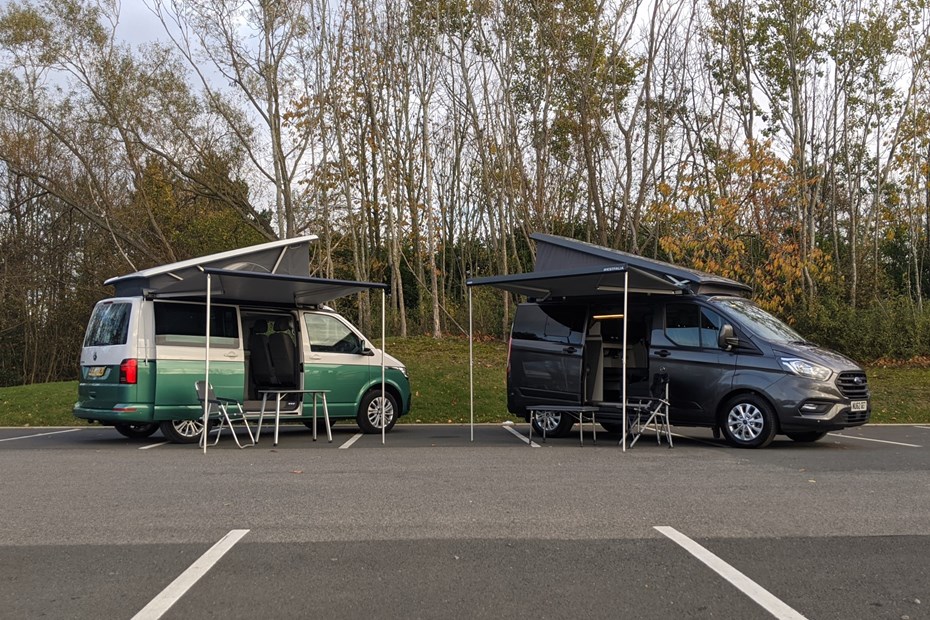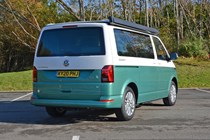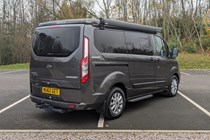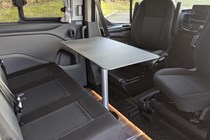Campervans are levelling up. No longer merely the go-to motor for surfers, bearded types and amateur detectives, staycating families, solo adventurers and those trying to avoid massive mortgage rates can benefit from the evolution of the humble, yet happy, camper. The iconic Volkswagen California, and a relative newbie, the Ford Transit Custom Nugget both offer car-like levels of fit and finish, space for four to live in comfort and modern, efficient base vehicles—directly from the manufacturer.
DIY campervan conversions have become more fashionable, better-equipped and less dowdy, and the vans themselves have come to be pretty cool items in their own rights. Motor manufacturers unsurprisingly want a bit of the action. They’re putting campervans on sale right alongside their standard model line-ups of cars and vans. Both the VW California and Ford Transit Custom Nugget can be ordered in a main dealer.
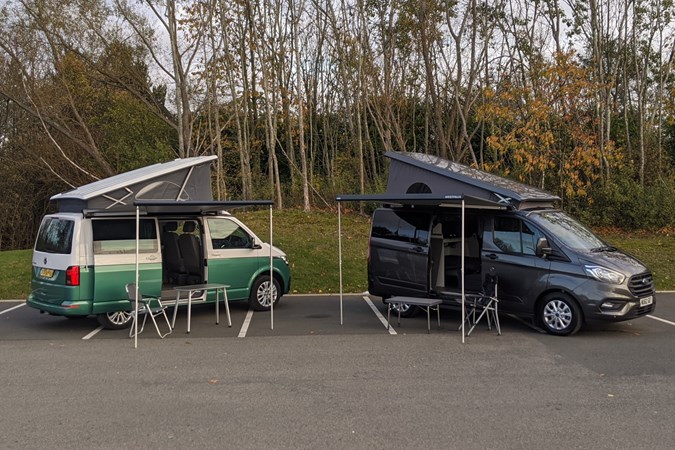
What’s more, their warranties and maintenance will be guaranteed by the car brands themselves. This is a shift away from the way it used to be done and streamlines the life admin for busy folks. Being factory conversions, you’re also less likely to be troubled by the confusion surrounding campervan speed limits.
If you’re interested in a specific aspect of either van, click the links below to jump straight to the relevant section, or read on for our full comparison test of these key campervan competitors.
Introduction
Volkswagen California
Ford Transit Custom Nugget
Verdict
What are they?
We’ll start with the Volkswagen. The VW California was originally introduced in the 1980s – it was based on the rear-engined Volkswagen T3 Transporter and converted into a motorhome by camping giant Westfalia. That’s not forgetting the scores of vans that came before it – camping in a Volkswagen Transporter goes all the way back to the T1 and iconic ‘splittie’ campers.
>> The 70 year history of the Volkswagen Transporter
In 2003, Volkswagen decided to revive the name on its T5 Transporter, but instead of handing off camping duties to Westfalia it took them on itself, building a specific factory just for campervans. Nowadays, it’s based on the very latest T6.1 Transporter.
Because everything on the California is done in-house, Volkswagen has a greater degree of control. It’s able to sell the campervans in its regular Volkswagen Commercial Vehicles dealerships alongside panel vans and working vehicles.
The Transit Custom Nugget takes a more traditional approach. While Westfalia no longer builds the California, it does take care of Ford’s camper.
In fact, the Westfalia Nugget–based on the Transit Custom has been around for years. It’s only with this latest conversion that Ford’s decided to take a greater hand in the process, giving the Nugget its blessing, selling it via main dealers.
These two campers are based on two of our favourite mid-sized panel vans. They have high-quality interior conversions, pop-top roofs, room to sleep four and similarly premium price tags. But which one is better?
Volkswagen California
You’ve likely noticed a California or two out on the road. Volkswagen leans in to the retro vibe such a camper brings. This means plenty of chrome as well as some very eye-catching two-tone colour schemes.
It’s available in three distinct flavours. Beach models are more basic and utilitarian, doing without a full kitchen and thus barely qualifying for campervan status. Coast and Ocean models have the same properly-fitted kitchen layout, with the former making do with slightly less equipment for a lower starting price.
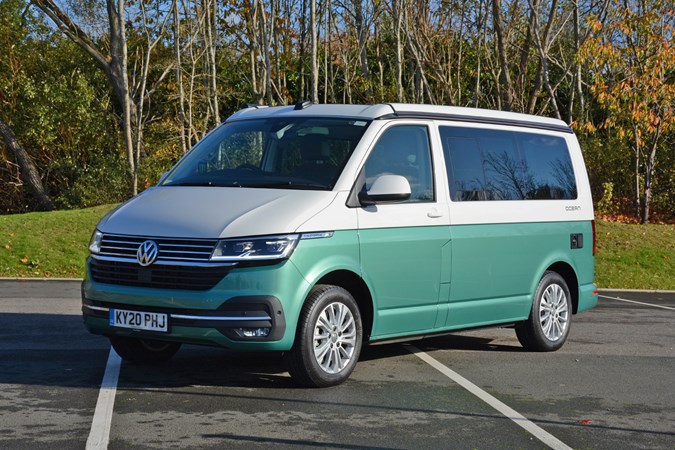
As for price, our test model – a 200hp Ocean – comes in at a hefty £72,235 after a few optional extras. These include £2,880 for the gorgeous two-tone paint, along with several other options such as high beam assist or an electric sliding door. Without these, it’s a more reasonable £66,643.
Base vehicle and conversion specs
The California is based on the latest Volkswagen T6 Transporter van, a robust choice with its car-like cabin. Next to the Nugget, which is based on Parkers award-winning Ford Transit Custom, the California does feel rather heavy and staid to drive.
It’s a heavy camper, so Volkswagen offers only its two higher-powered engine choices. You can have a 150hp or 200hp turbodiesel – the former is available with a six-speed manual gearbox in Beach or Coast forms. All other models use a seven-speed DSG automatic, and on top models you can even specify four-wheel drive.
Our test van, a 200hp automatic with front-wheel drive, claims to return up to 38.7mpg and emit 223g/km of CO2. During our testing, we easily matched that fuel economy figure, and on lightly loaded longer runs it crept over 40mpg with little effort.
Though you feel the California’s weight when cornering or braking, the powerful engines make short work of moving it along. It’s an effortless cruiser, soaking up bumps well. The steering’s light and accurate enough to make town work easy too.
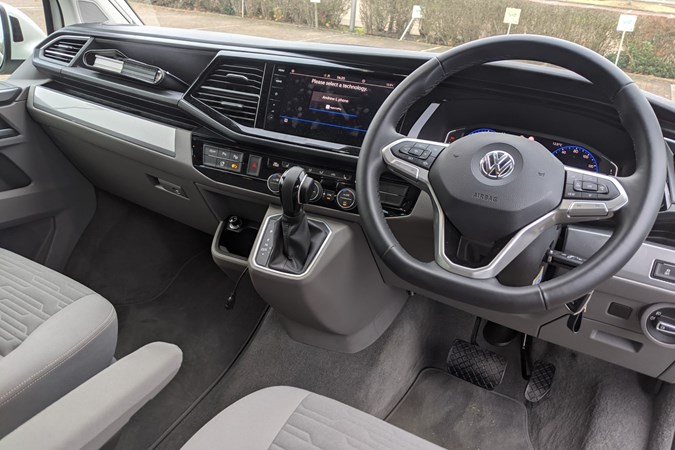
The front seats are comfortable and supportive with have twin armrests. Yet, due to the swivel mechanism they’re set rather high and can’t be lowered. The rear bench, meanwhile, is flat, with a very long base, and not the most comfortable for travel. It provides seating for four in total, while the Ford Nugget is a full five-seater.
The California’s fresh and waste water tanks are 30 litres each, and it can accommodate a 2.8kg gas cylinder. Space heating is powered by diesel and blown air.
Layout
The California uses the most traditional layout for a mid-sized campervan. Twin swivelling cab seats turn to face a rear compartment featuring a side kitchenette opposite a single sliding door, as well as a rear bench that folds flat into a double bed.
This makes for a nicely convivial lounge area. The table is attached to the kitchen unit and slides neatly out of the way when it’s not needed – deployment is as simple as folding out a single stabilising leg.
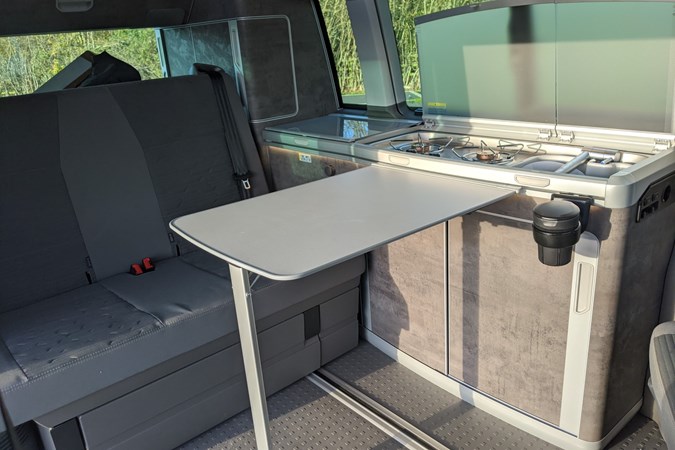
The rising roof is rear-hinged, while behind the rear seat there’s a good amount of ‘boot’ storage.
A quirk here is that the sliding door is on the ‘wrong’ side for the UK market; opening onto the driver’s side and therefore disgorging rear passengers into traffic. California owners have assured us, though, that this isn’t really much of a problem – there’s step-through access to the front, so rear passengers can easily exit through the front passenger door if they’re parked on a busy road.
Sleeping
There are two double-sized beds here, making for a total of four berths. They measure 200x120cm and 200x116cm respectively.
The roof bed is the larger of the two, and the more comfortable. Volkswagen provides a deep foam mattress that sits atop plastic springs, making it forgiving enough even for side-sleepers to get comfortable.
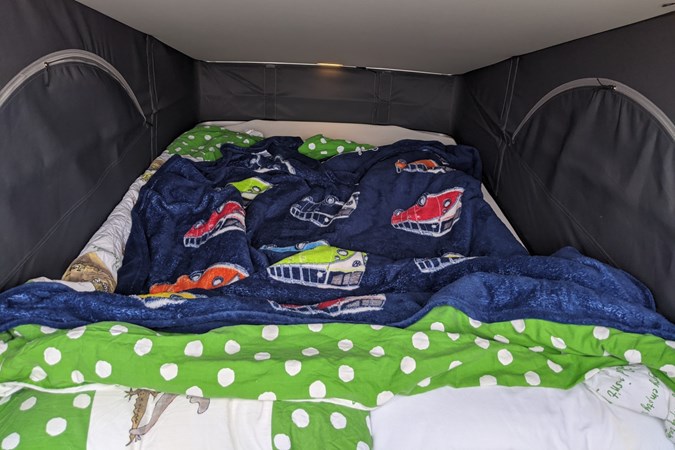
Lights in the roof panel illuminate the bed area nicely, and there are three zip-open windows to let in a cool breeze. The canvas is also very thick and dark, letting in very little unwanted sunshine so you won’t immediately wake up at first light.
Access isn’t the most elegant, though. You have to step up on to the front seats in order to get up. Once in bed, there are no convenient spots to leave a charging phone, glass of water or pair of glasses, unlike the Nugget. Ford’s design enables the top of its wardrobe to double as a bedside table.
The lower bed is very simple to make up in the classic rock’n’roll configuration. All you have to do is lower the rear headrests at the touch of a button, slide the seat forward slightly and lay the backrest flat.
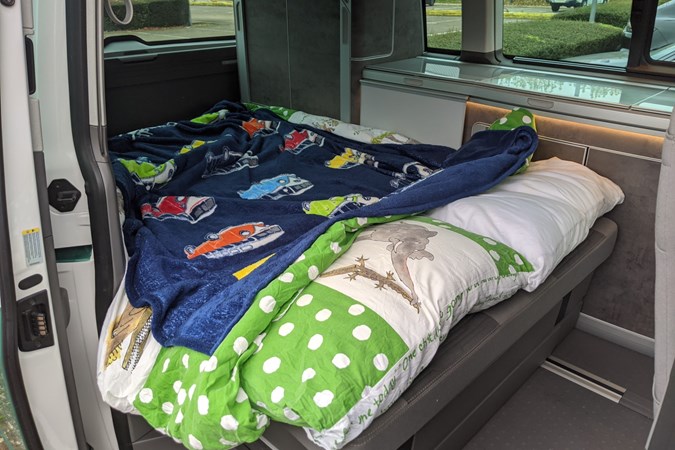
Once that’s done, thin mattress panels pull out from the rear portion to cover up the seat contours.
It’s best suited for two children or one adult, as it’s rather narrow and claustrophobic – and without opening windows, the air in the closed cabin can feel rather stale, too. It’s also a very firm mattress, so if you prefer a softer bed you’ll have to provide your own topper.
Cooking and eating
Like the Nugget, the California’s kitchen appointments are basic to say the least. They consist of a two-burner gas hob with spark ignition, a small sink with hot and cold running water, and a top-loading 42-litre fridge that runs off the mains or 12V electricity.
With the roof raised, you can theoretically stand at the cooker, but we suspect most will be cheffing from the rear bench. With the lid of the fridge lowered, it does provide a decent slab of workspace but unfortunately it’s located in an awkward spot – it’s much easier to simply use the dining table as a temporary food preparation zone instead.
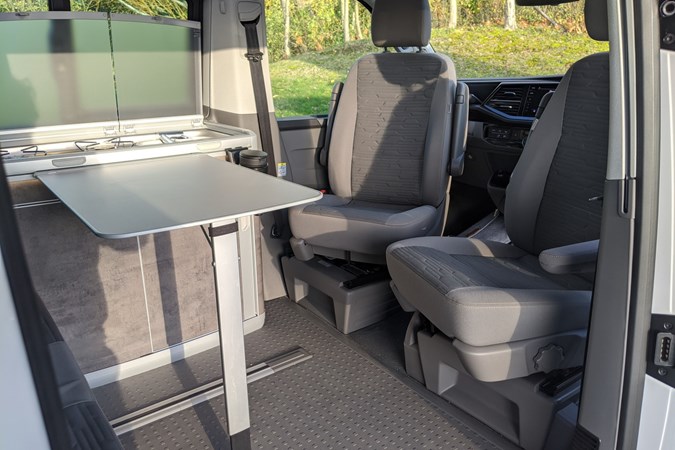
Dining indoors is easy, as the table slides to reach all four chairs. It’s also a treat to dine al fresco, which is easily accomplished – the California stores a freestanding table on the interior of the sliding door, and two heavy-duty and comfortable folding chairs within the rear tailgate. Both of those are ingenious storage solutions for what are usually very bulky and awkward pieces of equipment.
Storage
As well as the aforementioned chair and table, the California’s storage is very well thought-out. The most useful by far is the large boot area at the rear. This is subdivided by a parcel shelf of sorts – used for making the bed but also functioning as a very handy storage divider. There’s plenty of room underneath to store bulky items, and if you’re not using the downstairs bed then the top becomes available too.
Better yet, the parcel shelf can sit upright to allow you to carry taller items – or even come out entirely.
Around the rear you’ll find a tall storage cabinet, underneath which sits the gas bottle. The wardrobe is fore of this, just about accessible from either side of the rear seat. A cute little fold-out portion above the fridge holds a shaving mirror and a tiny shelf – ideal for holding toothpaste and toothbrushes so you can brush before bed.
A full-width drawer under the sliding rear bench can be used for bulky items, such as bedding, levelling wedges or simply the front door blinds. There’s also a permanent home for the awning winding handle in here, clipped securely in place.
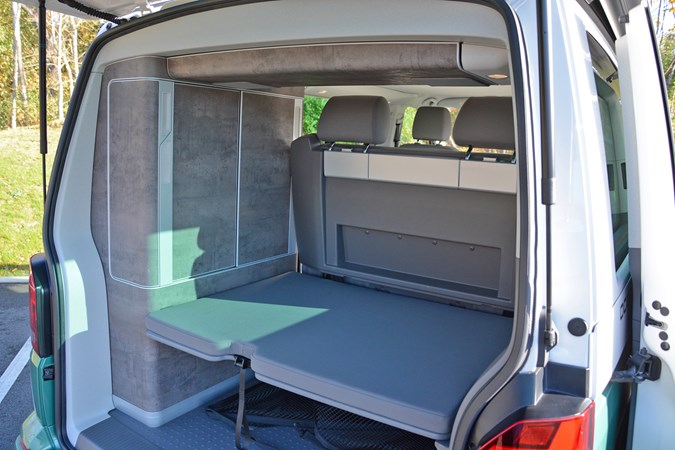
It’s kitchen storage that makes the most sense, as you get two wide, shelved cabinets and a capacious cutlery drawer. There’s plenty of room for cutlery, crockery and foodstuffs, and it’s all easily accessible. Truly impressive.
A notable omission is storage for a Porta Potti. Volkswagen expects you to splash out on the larger Grand California for a toilet facility. It would have been nice to have the option though, especially for families with young children.
Ford Transit Custom Nugget
The Ford Transit Custom is ubiquitous across the country. It’s one of the best-selling vehicles in the UK, let alone the best-selling panel van. Though our test van was in a very subtle dark grey, it’s also available in a rather more eye-catching bright orange which we’re big fans of.
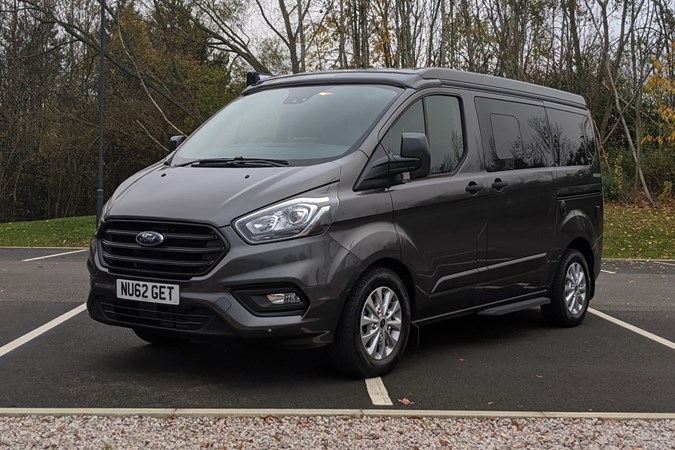
The Nugget’s available as seen here, with a manually-operated pop-top (as opposed to the California Ocean’s electric version). There’s also a longer Nugget, which is based on the long-wheelbase Transit Custom and includes a washroom at the rear with bench-style cassette toilet. It too has a pop-top roof.
Our test van is a 185hp model, and after a few options—including some we’d consider essential, such as a rear view camera and the so-called ICE Pack 25 (adaptive cruise control, touchscreen navigation and FordPass connectivity)—comes in at £65,816.
Base vehicle and conversion specs
The Ford Transit Custom needs little introduction. As a multiple Parkers Awards winner you can be assured it’s a VERY good product. It’s available with a wide array of diesel engines. For the Nugget, you can select from two; a 130hp or 185hp 2.0-litre diesel. The latter is available with a six-speed automatic and the one we had on test.
A claimed fuel economy figure of up to 36.2mpg wasn’t achieved this during our time with the van. You can expect it to be a little less efficient than the California overall, even though it’s less powerful. CO2 emissions of 230g/km just trail the California, too.
Driving the Nugget is very much like driving a standard Transit Custom though, and that’s a good thing. This van has the best steering on the market – it’s naturally-weighted, accurate and, dare we even say, dynamic?
It makes the Nugget more satisfying to drive than the California, though both are impressively stable on long motorway runs. The Nugget’s cabin is well-built and laid-out much like Ford’s smaller cars, such as the Focus. It doesn’t feel as solidly built as the Volkswagen’s, nor does it have quite so much impressive equipment. You’ll find no digital dashboard or LED headlights here, for example.
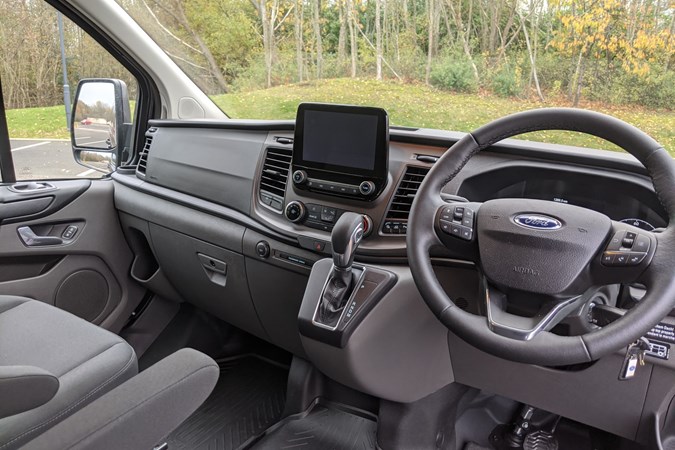
Ford’s front seats are just as supportive as Volkswagen’s, and the Nugget plays its first trump card over the California by having a three-seater rear bench. That means you can carry up to five people in here for travelling, rather than just four in the California. The rear bench is narrow and hard, though, so better suited to kids who won’t complain too much. And it’s worth mentioning that unless your three children are happy to share a double bed, this is still only a four-berth camper.
The Ford Nugget’s fresh and waste water tanks are larger than the California’s, at 42 litres apiece, and it has space for a 2.8kg gas bottle.
Layout
The Ford Nugget’s layout is startlingly different to the California’s, and not at all traditional. Not necessarily a bad thing! The kitchen is an L-shaped unit, situated at the rear with the rear travel seat directly ahead of it.
The roof is front-hinged, to allow for standing room over the kitchen, which means the lounge area is a little lower. Deploying the table isn’t as easy as it is in the California. You have to lift up the seat base to access a separate screw-in leg and table top.
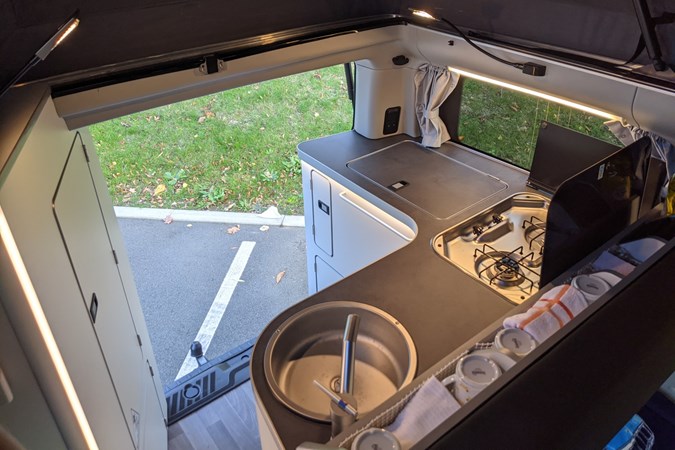
There are sliding doors on both sides, so accessing the rear seat is as simple as can be. Accessing the kitchen is via a narrow walkway to the side of the rear seat or through the lift-up tailgate.
Owners and aficionados we’ve spoken to have mixed feelings on the Nugget’s layout. Some have pointed out that it’s highly useful for families with small children – one parent can cook at the rear of the van while another entertains the young’uns at the front, away from hot pots and pans. However, it feels more cramped and less flexible than the California’s single space.
Sleeping
Like the California, the Nugget is a four-berth. The top bed is up in the pop-top and measures 200x138cm while the bottom bed measures 191x130cm.
Also like the California it’s up top where you’ll find a more comfortable night’s sleep, with a thick mattress topper and plastic springs. Access is granted through the use of a short ladder, which hooks onto the kitchen countertop.
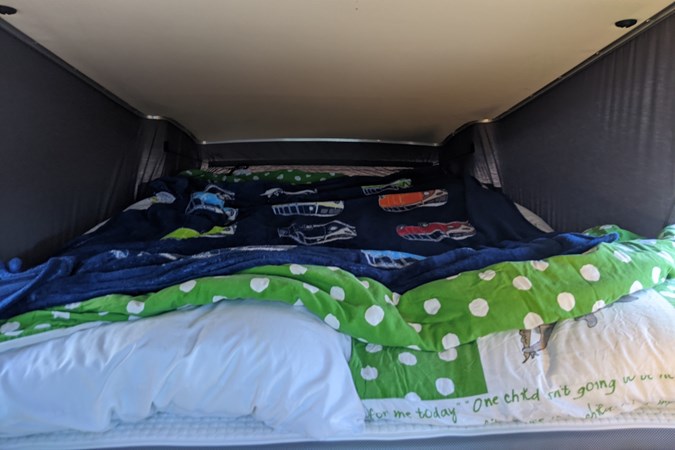
Bed makeup is where the California starts leaping ahead of the Nugget, however, as the Ford makes life rather awkward in this area.
For a start, the roof is manually-operated, and has a tendency to billow out when you’re lowering it, potentially leaving you with canvas flapping about in the breeze while you drive. Once you’re up in the roof bed, there’s no shutter to pull across beneath you. Though Ford does provide a sort of safety net, we couldn’t figure out where it hooked up.
The lower bed is far more awkward to make. Where Volkswagen’s rock’n’roll configuration is an effortless, three-step process, the Nugget is more of a challenge. First, you need to move the seat forwards using an incredibly stiff lever on the front. Then, using a second lever, tilt the base upwards and engage the mechanism that helps this portion to lie flat. This is a tricky manoeuvre that’ll take several attempts to get into your muscle memory.
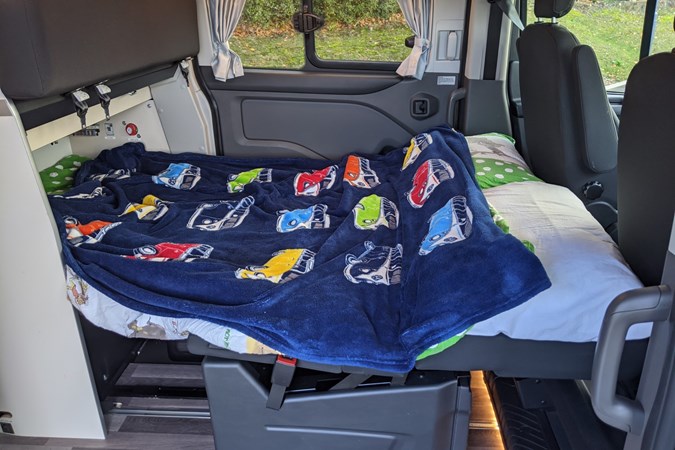
Once this section lies flat, you need to deploy an infill that folds up from beneath, before finally sliding the whole assembly back once more. All told, it’s a thoroughly awkward process that’s difficult to accomplish without stepping out of the van—no fun if it’s raining outside.
Once the lower bed is made up, you’ll find your feet rest underneath the kitchen countertop, in an area usually situated behind the backrest. That’s fine in practice, but this same area is used to store the Nugget’s two folding chairs while on the move – so you’ll have to find somewhere to stow them if you want to use the lower bed.
Another annoyance is privacy. Where the California has really premium-feeling roller blinds which can be lowered in an instant, the Nugget has curtains with incredibly fiddly popper-fittings. The front screens don’t even have them. They require insulated screens to be fitted using suction cups, leaving marks on the windscreen and falling off in the night.
Cooking and eating
The Nugget’s kitchen is L-shaped and has the same appointments as the California’s; two gas burners with spark ignition, a 40-litre top-loading compressor fridge, and a small sink with hot and cold running water.
It’s aimed rather more at the chef, though, with a little extra counter space. It’s also set higher so you can comfortably cook while standing up – necessary, as unlike the California there’s no easy way to sit while cooking.
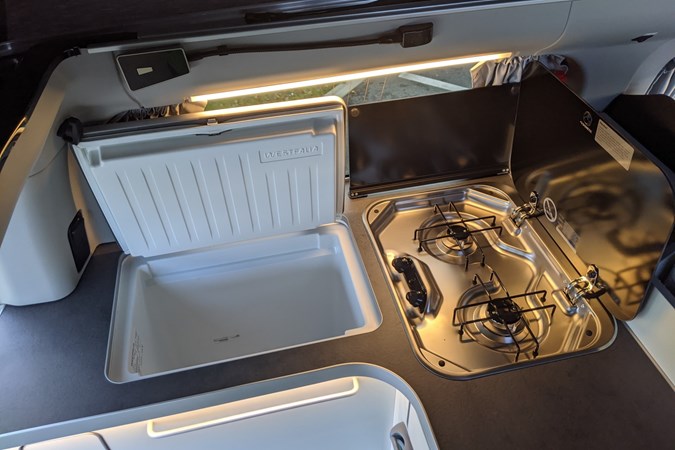
It’s much less forgiving for the larger frame than the California’s kitchen, however. With the trailing edge of the roof panel intruding on space, you’re forced to stand very close to the kitchen countertop, and it can be rather tricky to access lower-down storage.
As mentioned earlier, the interior table requires a bit more faff than the California’s, but once it’s in place it’s easily reachable from all seats. For dining outside, Ford provides two Westfalia-branded folding chairs, which store behind the rear seat backrest and a folding table which clips to the tailgate. The VW solution is neater here.
Storage
The Nugget offers plenty of storage spread across a few useful areas. There’s a large wardrobe area opposite the kitchen with a hanging rail and the ladder for the roof bed stored within. Underneath this, there’s a large cupboard suitable for a Porta Potti.
The kitchen has plenty of storage for small items A big cutlery drawer, tall cupboard and low-down compartment is suitable for pots and pans. It also has highly useful open storage bins on top of the counter, perfect for salt and pepper, washing-up liquid or any number of useful kitchen items.
There’s a tall cabinet next to the door which also has storage for a large, Ford-branded umbrella; a nice touch.
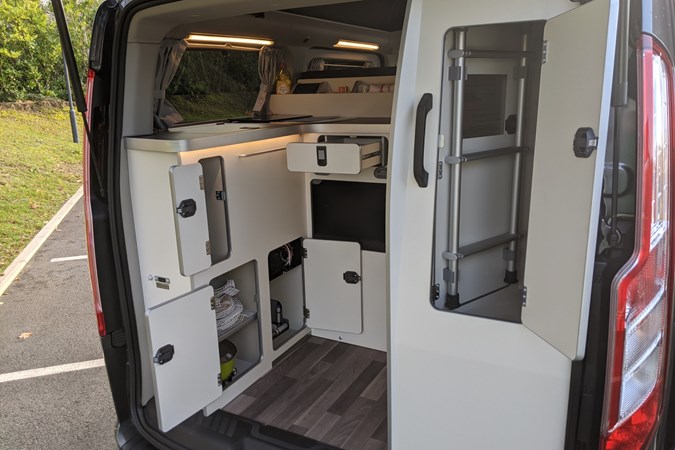
The largest storage compartment is under the rear bench. It’s square and useful but awkward to access. The seat base won’t stay up on its own, and it’s very heavy. It’s where Ford expects you to store many of the Nugget’s little necessities, such as the front window blinds, the awning handle and the interior table.
There’s no ‘boot’ area either, so it’s more difficult to use the Nugget as a second car for larger loads. That’s one of the California’s most useful features. It’s an ideal spot to put suitcases, bed linen or even groceries, and the lack of a similar spot in the Nugget reduces its utility outside of the world of camping.
Verdict
Were the Nugget much cheaper than the California, we’d be more tempted to forgive its foibles. However, once you remove the California’s paint and step down to the still perfectly acceptable 150hp engine, they’re more or less the same price. This is where we’d struggle to recommend the Nugget.
Some users will definitely prefer the Ford to the VW. The five-seater interior is an undeniable plus point. Though you can specify a third rear seat for the California, it’s an awkward and expensive addition. Separating the kitchen and lounge areas may also appeal to some, especially those who really like to cook in their vans – but to us, the California’s monospace interior makes more sense.
Even the vans themselves are further apart than we feel they ought to be. The basic California Ocean comes as standard with a high-definition touchscreen, virtual cockpit digital instrument panel, climate control and LED headlights. These features are all missing on the Ford.
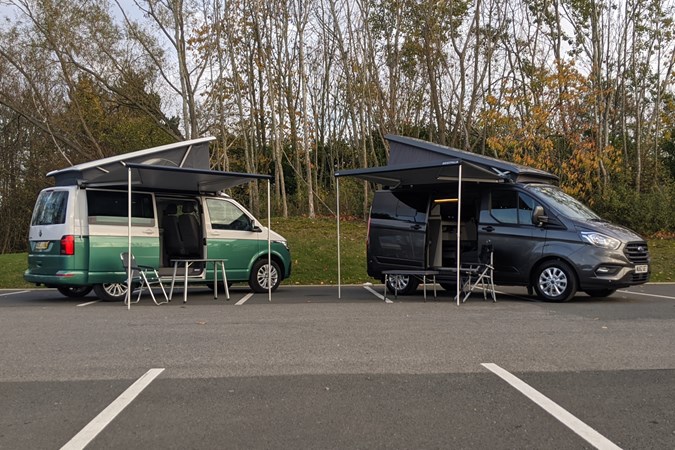
The devil’s really in the detail, though, especially when it comes to the conversion. This is where it becomes totally obvious that the Volkswagen was built from the ground up to be a campervan while the Nugget was converted by a third party. Every movement just takes a little more effort in the Ford, whether it’s making the bed, setting up the table, or even pulling the curtains at night.
The sense of quality within the Volkswagen is impossible to ignore, and every fixture and fitting feels more solid, better integrated and easier to live with than those in the Nugget.
For this reason we’d choose the California every time. Despite the cost, the build quality and the strength of the VW reputation results in staggeringly good residual values, which is ultimately better value.
Alternatives and future models
If neither of the above float your boat – or you’ve got money to burn – the Mercedes-Benz V-Class Marco Polo is the third factory-backed camper in this area of the market. Just updated for 2024 it very much a premium product; with a starting price of nearly £90,000 it’s more expensive than either major rival.
For that you do get more power – the Marco Polo V300d has 237hp and can do 0-62mph in 8.8 seconds, making it much faster than the competition, too – and for an extra £3,100 you can upgrade further to an air-suspension system that will level the van for you when parked. Making issues with bumpy camping grounds a thing of the past.
But that’s not all that’s new for 2024. This year we’re also expecting an all-new VW California based on the Multivan MPV and an all-new Ford Nugget based on the second-generation Transit Custom. We’ll bring you full reviews of both new models as soon as they’re available.
Further reading
Campervans tend to conjure up one of two images in most people’s heads. On one hand, you’ve got a great white fibreglass whale dawdling down to Devon at 3mph, loaded to the gunnels with sandwich spread and questionable velour upholstery. On the other, a troupe of lanky twentysomethings with an ancient Volkswagen, surfboards, a barbecue, and three pages of advisories on their MOT.
But in recent years campervans have become more popular with all sorts of people, from families to single adventurers. Conversions have become more fashionable, better-equipped and less dowdy, and the vans themselves have come to be pretty cool items in their own rights.
Their appeal has skyrocketed even further with all that 2020’s thrown at us. With the best-laid plans for international adventures mainly cancelled by the Covid-19 pandemic, so-called ‘staycations’ have come back into fashion, and interest in campervans has increased dramatically.
Such is their popularity that they’re not just the preserve of bit-part conversion companies any more – some motor manufacturers are getting involved and putting campervans on sale right alongside their standard model line-ups of cars and vans.
We’re testing two such vans today – the iconic Volkswagen California, and a relative newbie, the Ford Transit Custom Nugget.
What are they?
We’ll start with the Volkswagen. The VW California was originally introduced in the 1980s – it was based on the rear-engined Volkswagen T3 Transporter and converted into a motorhome by camping giant Westfalia. That’s not forgetting the scores of vans that came before it – camping in a Volkswagen Transporter goes all the way back to the T1 and iconic ‘splittie’ campers.
In 2003, Volkswagen decided to revive the name on its T5 Transporter, but instead of handing off camping duties to Westfalia it took them on itself, building a specific factory just for campervans. Nowadays, it’s based on the very latest T6 Transporter.
Because everything on the California is done in-house, Volkswagen has a greater degree of control, and is able to sell the campervans in its regular Volkswagen Commercial Vehicles dealerships alongside panel vans and working vehicles.
The Transit Custom Nugget takes a more traditional approach – and so while Westfalia no longer builds the California, it does take care of Ford’s camper.
In fact, the Westfalia Nugget – based on the Transit – has been around for years. It’s only with this latest conversion that Ford’s decided to take a greater hand in the process, giving the Nugget its blessing and selling it in main dealers.
These two campers are based on two of our favourite mid-sized panel vans – they have high-quality interior conversions, pop-top roofs, room to sleep four and similarly premium price tags. But which one is better?
Volkswagen California
You’ve likely noticed a California or two out on the road. Volkswagen leans in to the retro vibe such a camper brings, and as such offers it with plenty of chrome as well as some very eye-catching two-tone colour schemes.
It’s available in three distinct flavours. Beach models are more basic and utilitarian, doing without a full kitchen and thus barely qualifying for campervan status. Coast and Ocean models have the same properly-fitted kitchen layout, with the former making do with slightly less equipment to achieve a lower starting price.
As for price, our test model – a 200hp Ocean – comes in at a hefty £72,235 after a few optional extras. These include £2,880 for the gorgeous two-tone paint, along with several other options such as high beam assist or an electric sliding door. Without these, it’s a more reasonable £66,643.
Base vehicle and conversion specs
The California is based on the latest Volkswagen T6 Transporter van. It’s a very favourable starting point. We like its feeling of solidity and its car-like cabin, though next to the Nugget – based on the Parkers award-winning Ford Transit Custom – it does feel rather heavy and staid to drive.
The California is a heavy camper, so Volkswagen offers only its two higher-powered engine choices. You can have a 150hp or 200hp turbodiesel – the former is available with a six-speed manual gearbox in Beach or Coast forms. All other models use a seven-speed DSG automatic, and on top models you can even specify four-wheel drive.
Our test van, a 200hp automatic with front-wheel drive, claims to return up to 38.7mpg and emit 223g/km of CO2. During our testing we easily matched that fuel economy figure, and on lightly loaded longer runs it crept over 40mpg with little effort.
Though you feel the California’s weight when cornering or braking, the powerful engines make short work of moving it along. It’s an effortless cruiser, soaking up bumps well – yet the steering’s light and accurate enough to make town work easy.
The front seats are comfortable and supportive and have twin armrests, but due to the swivel mechanism they’re set rather high and can’t be lowered. The rear bench, meanwhile, is flat, with a very long base, and not the most comfortable for travel. It provides seating for four in total, while the Ford Nugget is a full five-seater.
The California’s fresh and waste water tanks are 30 litres each, and it can accommodate a 2.8kg gas cylinder. Space heating is powered by diesel and blown air.
Layout
The California uses the most traditional layout for a mid-sized campervan. Twin swivelling cab seats turn to face a rear compartment featuring a side kitchenette opposite a single sliding door, as well as a rear bench that folds flat into a double bed.
This makes for a nicely convivial lounge area. The table is attached to the kitchen unit and slides neatly out of the way when it’s not needed – deployment is as simple as folding out a single stabilising leg.
The rising roof is rear-hinged, while behind the rear seat there’s a good amount of ‘boot’ storage.
A quirk here is that the sliding door is on the ‘wrong’ side for the UK market, opening onto the driver’s side and therefore disgorging rear passengers into traffic. California owners have assured us, though, that this isn’t really much of a problem – there’s step-through access to the front, so rear passengers can easily exit through the front passenger door if they’re parked on a busy road.
Sleeping
There are two double-sized beds here, making for a total of four berths. They measure 200x120cm and 200x116cm respectively.
The roof bed is the larger of the two, and the more comfortable – Volkswagen provides a deep foam mattress that sits atop plastic springs, making it forgiving enough even for side-sleepers to get comfortable.
Lights in the roof panel illuminate the bed area nicely, and there are three zip-open windows to let in a cooling breeze. The canvas is also very thick and dark, letting in very little unwanted sunshine so you won’t immediately wake up at first light.
Access isn’t the most elegant, though – you have to step up on to the front seats in order to get up, and once in bed there are no convenient spots to leave a charging phone, glass of water or pair of glasses – unlike the Nugget, which allows the top of its wardrobe to double as a bedside table.
The lower bed is very simple to make up in the classic rock’n’roll configuration. All you have to do is lower the rear headrests at the touch of a button, slide the seat forward slightly and lay the backrest flat.
Once that’s done, thin mattress panels pull out from the rear portion to cover up the seat contours.
It’s best suited for two children or one adult, as it’s rather narrow and claustrophobic – and without opening windows, the air in the closed cabin can feel rather stale, too. It’s also a very firm mattress, so if you prefer a softer bed you’ll have to provide your own topper.
Cooking and eating
Like the Nugget, the California’s kitchen appointments are basic to say the least. They consist of a two-burner gas hob with spark ignition, a small sink with hot and cold running water, and a top-loading 42-litre fridge that runs off the mains or 12V electricity.
With the roof raised, you can theoretically stand at the cooker, but we suspect most will be cheffing from the rear bench. With the lid of the fridge lowered, it does provide a decent slab of workspace but unfortunately it’s located in an awkward spot – it’s much easier to simply use the dining table as a temporary food preparation zone instead.
Dining indoors is easy, as the table slides to reach all four chairs. It’s also a treat to dine al fresco, which is easily accomplished – the California stores a freestanding table on the interior of the sliding door, and two heavy-duty and comfortable folding chairs within the rear tailgate. Both of those are ingenious storage solutions for what are usually very bulky and awkward pieces of equipment.
Storage
As well as the aforementioned chair and table, the California’s storage is very well thought-out. The most useful by far is the large boot area at the rear. This is subdivided by a parcel shelf of sorts – used for making the bed but also functioning as a very handy storage divider. There’s plenty of room underneath to store bulky items, and if you’re not using the downstairs bed then the top becomes available too.
Better yet, the parcel shelf can sit upright to allow you to carry taller items – or even come out entirely.
Also round the rear you’ll find a tall storage cabinet, underneath which sits the gas bottle. The wardrobe is fore of this, just about accessible from either side of the rear seat. A cute little fold-out portion above the fridge holds a shaving mirror and a tiny shelf – ideal for holding toothpaste and toothbrushes so you can brush before bed.
A full-width drawer under the sliding rear bench can be used for bulky items – whether bedding, levelling wedges or simply the front door blinds. There’s also a permanent home for the awning winding handle in here, clipped securely in place.
It’s kitchen storage that makes the most sense, as you get two wide, shelved cabinets and a capacious cutlery drawer. There’s plenty of room for cutlery, crockery and foodstuffs, and it’s all superbly easily accessible.
A notable omission is storage for a Porta Potti – Volkswagen expects you to splash out on the larger Grand California if you want any sort of toilet facility, though it would have been nice to have the option especially for families with young children.
Ford Transit Custom Nugget
The Ford Transit Custom is ubiquitous across the country – it’s one of the best-selling vehicles in the UK, period, let alone the best-selling panel van. Though our test van was in a very subtle dark grey, it’s also available in a rather more eye-catching bright orange which we’re big fans of.
The conversion is at least as obvious as the California’s, though the ‘Nugget’ and ‘Westfalia branding on the sides and the leading edge of the rising roof are a little more on-the-nose.
The Nugget’s available as seen here, with a manually-operated pop-top (as opposed to the California Ocean’s electric version). There’s also a longer Nugget, which is based on the long-wheelbase Transit Custom and includes a washroom at the rear with bench-style cassette toilet. It too has a pop-top roof.
Our test van is a 185hp model, and after a few options – including some we’d consider essential, such as a rear view camera and the so-called ICE Pack 25 (adaptive cruise control, touchscreen navigation and FordPass connectivity) comes in at £65,816.
Base vehicle and conversion specs
The Ford Transit Custom needs little introduction, but as a Parkers award-winner in the medium-sized van category you can be assured it’s a damn good product. It’s available with a wide array of diesel engines, but for the Nugget you can select from two – a 130hp or 185hp 2.0-litre diesel. The latter is available with a six-speed automatic, and our test van was specified thusly.
That means a claimed fuel economy figure of up to 36.2mpg, though we didn’t quite hit this during our time with the van – expect it to be a little less efficient than the California overall, even though it’s less powerful. CO2 emissions of 230g/km just trail the California, too.
Driving the Nugget is very much like driving a standard Transit Custom though, and that’s a good thing. This van has the best steering on the market – it’s naturally-weighted, accurate, and dare we even say dynamic?
It makes the Nugget more satisfying to drive than the California, though both are impressively stable on long motorway runs. The Nugget’s cabin is well-built and laid-out much like Ford’s smaller cars, such as the Focus – but it doesn’t feel as solidly built as the Volkswagen’s, nor does it have quite so much impressive equipment. You’ll find no digital dashboard or LED headlights here, for example.
Ford’s front seats are just as supportive as Volkswagen’s, and the Nugget plays its first trump card over the California by having a three-seater rear bench. That means you can carry up to five people in here for travelling, rather than just four in the California. The rear bench is narrow and hard, though, so better suited to kids who won’t complain too much. And it’s worth mentioning that unless your three children are happy to share a double bed, this is still only a four-berth camper.
The Ford Nugget’s fresh and waste water tanks are larger than the California’s, at 42 litres apiece, and it has space for a 2.8kg gas bottle.
Layout
The Ford Nugget’s layout is startlingly different to the California’s, and not at all traditional – not that that’s necessarily a bad thing! The kitchen is an L-shaped unit, situated at the rear with the rear travel seat directly ahead of it.
The roof is front-hinged, to allow for standing room over the kitchen, which means the lounge area is a little lower. Deploying the table isn’t as easy as it is in the California – you have to lift up the seat base to access a separate screw-in leg and table top.
There are sliding doors on both sides, so accessing the rear seat is as simple as can be, while the kitchen can be accessed by a narrow walkway to the side of the rear seat or through the lift-up tailgate.
Owners and aficionados we’ve spoken to have mixed feelings on the Nugget’s layout. Some have pointed out that it’s highly useful for families with small children – one parent can cook at the rear of the van while another entertains the young’uns at the front, away from hot pots and pans. However, it feels more cramped and less flexible than the California’s single space.
Sleeping
Like the California, the Nugget is a four-berth. The top bed is up in the pop-top and measures 200x138cm while the bottom bed measures 191x130cm.
Also like the California it’s up top where you’ll find a more comfortable night’s sleep, with a thick mattress topper and plastic springs. Access is granted through the use of a short ladder, which hooks onto the kitchen countertop.
Bed makeup is where the California starts leaping ahead of the Nugget, however, as the Ford makes life rather awkward in this area.
For a start, the roof is manually-operated, and has a tendency to billow out when you’re lowering it, potentially leaving you with canvas flapping about in the breeze while you drive. Once you’re up in the roof bed, there’s no shutter to pull across beneath you, and though Ford does provide a sort of safety net, we couldn’t figure out where it hooked up.
The lower bed is far more of a pig to make up, though. Where Volkswagen’s rock’n’roll configuration is an effortless, three-step process, the Nugget’s is rather more complex. First, you need to move the seat forwards using an incredibly stiff lever on the front. Then, using a second lever, tilt the base upwards and engage the mechanism that helps this portion to lie flat. This is a tricky manoeuvre that’ll take several attempts to get into your muscle memory.
Once this section lies flat, you need to deploy an infill that folds up from beneath, before finally sliding the whole assembly back once more. All told, it’s a thoroughly awkward process that’s difficult to accomplish without stepping out of the van – no fun if it’s raining outside.
Once the lower bed is made up, you’ll find your feet rest underneath the kitchen countertop, in an area usually situated behind the backrest. That’s fine in practice, but this same area is used to store the Nugget’s two folding chairs while on the move – so you’ll have to find somewhere to stow them if you want to use the lower bed.
Another annoyance is privacy. Where the California has really premium-feeling roller blinds which can be lowered in an instant, the Nugget has curtains with popper-fittings which are incredibly fiddly. The front screens don’t even have that – they require insulated screens to be fitted using suction cups, which leave marks on the windscreen and have a tendency to fall off in the middle of the night.
Cooking and eating
The Nugget’s kitchen is L-shaped and has the same appointments as the California’s – two gas burners with spark ignition, a 40-litre top-loading compressor fridge, and a small sink with hot and cold running water.
It’s aimed rather more at the chef, though, with a little extra counter space. It’s also set higher so you can comfortably cook while standing up – necessary, as unlike the California there’s no easy way to sit while cooking.
It’s much less forgiving for the larger frame than the California’s kitchen, however. With the trailing edge of the roof panel intruding on space, you’re forced to stand very close to the kitchen countertop, and it can be rather tricky to access lower-down storage.
As mentioned earlier, the interior table requires a bit more faff than the California’s, but once it’s in place it’s easily reachable from all seats. For dining outside, Ford provides two Westfalia-branded folding chairs, which store behind the rear seat backrest (not as tidy as VW’s solution in the rear door) and a folding table which clips to the tailgate.
Storage
The Nugget offers plenty of storage spread across a few useful areas. There’s a large wardrobe area opposite the kitchen, which has a hanging rail and the ladder for the roof bed stored within. Underneath this there’s a large cupboard suitable for a Porta Potti.
The kitchen has plenty of storage for small items – a big cutlery drawer, tall cupboard and low-down compartment suitable for pots and pans. It also has highly useful open storage bins on top of the counter – perfect for salt and pepper, washing-up liquid or any number of useful kitchen items.
There’s a tall cabinet next to the door which also has storage for a large, Ford-branded umbrella – a nice touch.
The largest storage compartment is under the rear bench, which is square and useful but awkward to access, as the seat base won’t stay up on its own – and it’s very heavy. It’s where Ford expects you to store many of the Nugget’s little necessities, such as the front window blinds, the awning handle and the interior table.
There’s no ‘boot’ area either, so it’s more difficult to use the Nugget as a second car for larger loads. That’s one of the California’s most useful features – it’s an ideal spot to put suitcases, bed linen or even groceries, and the lack of a similar spot in the Nugget reduces its utility outside of the world of camping.
Verdict
Were the Nugget much cheaper than the California, we’d be more tempted to forgive its foibles. However, once you remove the California’s paint and step down to the still perfectly acceptable 150hp engine, they’re more or less the same price. And this is where we’d struggle to recommend the Nugget.
Some users will definitely prefer the Ford to the VW. The five-seater interior is an undeniable plus point – you can specify a third rear seat for the California, but it’s an awkward and expensive addition. Separating the kitchen and lounge areas may also appeal to some, especially those who really like to cook in their vans – but to us, the California’s monospace interior makes more sense.
Even the vans themselves are further apart than we feel they ought to be – the basic California Ocean comes as standard with a high-definition touchscreen, virtual cockpit digital instrument panel, climate control and LED headlights. These features are all missing on the Ford.
The devil’s really in the detail, though, especially when it comes to the conversion. This is where it becomes totally obvious that the Volkswagen was built from the ground up to be a campervan while the Nugget was converted by a third party. Every movement just takes a little more effort in the Ford – whether it’s making the bed, setting up the table, or even pulling the curtains at night.
The sense of quality within the Volkswagen is impossible to ignore, and every fixture and fitting feels more solid, better integrated and easier to live with than those in the Nugget.
For this reason we’d choose the California every time. Yes, it’s easy to specify it to be more expensive than the Nugget, but with such quality – and with the strength of the Volkswagen name behind it, which results in staggeringly good residual values – we think it’s actually better valu
Further reading:>> Fancy something bigger? Read our full Volkswagen Grand California review
>> Motorhome buying advice: which body type is right for me?
>> Volkswagen launches Motorhome Qualification Scheme
>> The Parkers guide to camping
Just so you know, we may receive a commission or other compensation from the links on this website - read why you should trust us.


